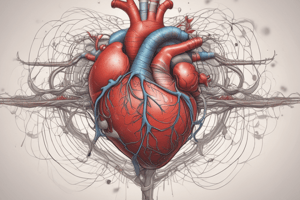Podcast
Questions and Answers
Blood returning to the heart from the systemic circuit first enters the?
Blood returning to the heart from the systemic circuit first enters the?
right atrium
Blood returning to the heart from the pulmonary circuit first enters the?
Blood returning to the heart from the pulmonary circuit first enters the?
left atrium
What does the coronary sulcus mark?
What does the coronary sulcus mark?
marks the border between the atria and ventricles
The right ventricle pumps blood to the?
The right ventricle pumps blood to the?
The left ventricle pumps blood to the?
The left ventricle pumps blood to the?
The right atrium receives blood from the?
The right atrium receives blood from the?
Blood flowing into the heart from the venae cavae flows next through the ________ valve.
Blood flowing into the heart from the venae cavae flows next through the ________ valve.
As blood leaves the right ventricle it passes through the ________ and then into the pulmonary trunk.
As blood leaves the right ventricle it passes through the ________ and then into the pulmonary trunk.
The pulmonary semilunar valve prevents backward flow into the?
The pulmonary semilunar valve prevents backward flow into the?
The bicuspid or mitral valve is located?
The bicuspid or mitral valve is located?
Match the following vessels and structures associated with the heart:
Match the following vessels and structures associated with the heart:
In cardiac muscle, the fast depolarization phase of the action potential is the result of?
In cardiac muscle, the fast depolarization phase of the action potential is the result of?
The long plateau phase of the cardiac muscle action potential is due to?
The long plateau phase of the cardiac muscle action potential is due to?
In cardiac muscle, at least half of the calcium ion required for contraction comes from?
In cardiac muscle, at least half of the calcium ion required for contraction comes from?
Match the following structural components of the conducting system of the heart:
Match the following structural components of the conducting system of the heart:
The first heart sound is heard when the?
The first heart sound is heard when the?
During the isovolumetric phase of ventricular systole, the?
During the isovolumetric phase of ventricular systole, the?
The volume of blood ejected from each ventricle during a contraction is called the?
The volume of blood ejected from each ventricle during a contraction is called the?
The phase in the cardiac cycle when the mitral valve is closed and the aortic valve is open is the?
The phase in the cardiac cycle when the mitral valve is closed and the aortic valve is open is the?
________ is to contraction as ________ is to relaxation.
________ is to contraction as ________ is to relaxation.
Blood leaves the right ventricle by passing through the?
Blood leaves the right ventricle by passing through the?
Stroke volume depends on?
Stroke volume depends on?
Cardiac output can be increased by all of the following except one. Choose the exception.
Cardiac output can be increased by all of the following except one. Choose the exception.
During ventricular systole, the?
During ventricular systole, the?
Which of the following is greater during left ventricular systole?
Which of the following is greater during left ventricular systole?
Flashcards are hidden until you start studying
Study Notes
Heart Anatomy and Blood Flow
- Blood from the systemic circuit enters the right atrium.
- Blood from the pulmonary circuit enters the left atrium.
- The coronary sulcus marks the border between atria and ventricles.
Heart Function and Blood Pumping
- The right ventricle pumps blood to the right and left lungs.
- The left ventricle pumps blood to the aorta.
- The right atrium receives blood from the coronary sinus, superior vena cava, and inferior vena cava.
- Blood from the venae cavae flows through the tricuspid valve next.
- Blood leaves the right ventricle through the conus arteriosus into the pulmonary trunk.
Valves and Blood Flow Regulation
- The pulmonary semilunar valve prevents blood from flowing back into the right ventricle.
- The bicuspid (mitral) valve is positioned between the left atrium and left ventricle.
Blood Circulation Pathway
- Blood circulation order: venae cavae, right atrium, right ventricle, pulmonary trunk, pulmonary veins, left atrium, left ventricle, aorta.
Cardiac Action Potentials
- Fast depolarization in cardiac muscle results from increased sodium ion permeability.
- The long plateau phase in action potentials occurs due to open calcium channels.
- At least half of the calcium required for contraction enters cardiac muscle cells from outside.
Heart Conducting System
- The structural components of the cardiac conductive system include the SA node, AV node, AV bundle, bundle branches, and Purkinje fibers, in that order.
Heart Sounds and Phases
- The first heart sound occurs when AV valves close.
- During isovolumetric ventricular systole, both AV valves and semilunar valves are closed.
Stroke Volume and Cardiac Output
- Stroke volume is defined as the volume of blood ejected from each ventricle during a contraction.
- The systolic ejection phase is when the mitral valve is closed, and the aortic valve is open.
- Stroke volume is influenced by end diastolic volume, ventricle contractility, and pressure required to pump blood into the aorta.
- Cardiac output can decrease if ejection fraction decreases.
Ventricle Function During Systole
- During ventricular systole, the AV valves are closed while peak pressure occurs in the left ventricle.
Key Terms
- Systole refers to contraction, while diastole refers to relaxation.
- Ejection is associated with systole, and filling is associated with diastole.
Studying That Suits You
Use AI to generate personalized quizzes and flashcards to suit your learning preferences.




